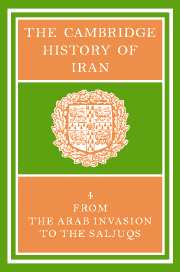Book contents
- Frontmatter
- 1 THE ARAB CONQUEST OF IRAN AND ITS AFTERMATH
- 2 THE ‘ABBĀSID CALIPHATE IN IRAN
- 3 THE ṬĀHIRIDS AND ṢAFFĀRIDS
- 4 The SĀMĀNIDS
- 5 THE EARLY GHAZNAVIDS
- 6 THE MINOR DYNASTIES OF NORTHERN IRAN
- 7 IRAN UNDER THE BŪYIDS
- 8 TRIBES, CITIES AND SOCIAL ORGANIZATION
- 9 THE VISUAL ARTS
- 10 NUMISMATICS
- 11 THE EXACT SCIENCES
- 12 LIFE SCIENCES, ALCHEMY AND MEDICINE
- 13(a) PHILOSOPHY AND COSMOLOGY
- (b) SŪFISM
- 14 THE RELIGIOUS SCIENCES
- 15 SECTS AND HERESIES
- 16 NĀSIR-I KHUSRAU AND IRANIAN ISMĀ‘ĪLĪSM
- 17 ZOROASTRIAN LITERATURE AFTER THE MUSLIM CONQUEST
- 18 ARABIC LITERATURE IN IRAN
- 19 THE RISE OF THE NEW PERSIAN LANGUAGE
- 20 (a) THE “RUBĀ'Ī” IN EARLY PERSIAN LITERATURE
- (b) ‘UMAR KHAYYĀM: ASTRONOMER, MATHEMATICIAN AND POET
- Bibliography
- Index
- Plate section
- Plate section">
- Map 1. Iran under the Abbasids">
- References
1 - THE ARAB CONQUEST OF IRAN AND ITS AFTERMATH
Published online by Cambridge University Press: 28 March 2008
- Frontmatter
- 1 THE ARAB CONQUEST OF IRAN AND ITS AFTERMATH
- 2 THE ‘ABBĀSID CALIPHATE IN IRAN
- 3 THE ṬĀHIRIDS AND ṢAFFĀRIDS
- 4 The SĀMĀNIDS
- 5 THE EARLY GHAZNAVIDS
- 6 THE MINOR DYNASTIES OF NORTHERN IRAN
- 7 IRAN UNDER THE BŪYIDS
- 8 TRIBES, CITIES AND SOCIAL ORGANIZATION
- 9 THE VISUAL ARTS
- 10 NUMISMATICS
- 11 THE EXACT SCIENCES
- 12 LIFE SCIENCES, ALCHEMY AND MEDICINE
- 13(a) PHILOSOPHY AND COSMOLOGY
- (b) SŪFISM
- 14 THE RELIGIOUS SCIENCES
- 15 SECTS AND HERESIES
- 16 NĀSIR-I KHUSRAU AND IRANIAN ISMĀ‘ĪLĪSM
- 17 ZOROASTRIAN LITERATURE AFTER THE MUSLIM CONQUEST
- 18 ARABIC LITERATURE IN IRAN
- 19 THE RISE OF THE NEW PERSIAN LANGUAGE
- 20 (a) THE “RUBĀ'Ī” IN EARLY PERSIAN LITERATURE
- (b) ‘UMAR KHAYYĀM: ASTRONOMER, MATHEMATICIAN AND POET
- Bibliography
- Index
- Plate section
- Plate section">
- Map 1. Iran under the Abbasids">
- References
Summary
IRANIANS AND ARABS IN PRE-ISLAMIC TIMES
The Muslim Arabs' disastrous defeat of the Sāsānian Empire opened a new chapter in the long history of Iran. In distant Hijāz in the city of Mecca, Muhammad b. 'Abd-Allāh had given to an idolatrous and strife-ridden people a new religion, which inculcated monotheism, its message coming to Muhammad as Revelation, conveyed to his Community later in the Qur'ān, and bade the Arabs to submit as people accountable to God and fearful of his wrath. Some of them were so inspired by this new teaching that they undertook the conquest of the world about them, to achieve at the same time in this holy war the reward of a share in the world to come, Paradise.
Muhammad's death in 11/632 was followed in his successor Abū Bakr's time by a crisis of apostasy, the Ridda, which put both the religion and the government of Medina in jeopardy. The faith and the polity which Muhammad had promulgated there were shaken, but nonetheless the new Islamic vigour was enough to achieve dominion over all the Arabian Peninsula. Once the apostasy had been suppressed, closer unity followed with greater zeal to sacrifice all in a larger struggle. The end of the Ridda wars left the Arabs poised for Holy War for the sake of Islam, ready to challenge even Byzantium and Iran.
From as early as before the advent of Alexander the Great Arabs had been known to Iran. In the Sāsānian period, from A.D. 226 to 651, their jurisdiction reached as far as the western outskirts of Ctesiphon. According to Tabarī, Shāpūr I (A.D. 241–72) had settled some of the tribe of Bakr b. Wa'il in Kirmān.
- Type
- Chapter
- Information
- The Cambridge History of Iran , pp. 1 - 56Publisher: Cambridge University PressPrint publication year: 1975
References
- 8
- Cited by

